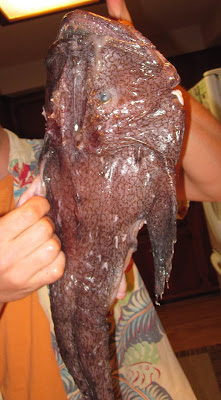Judy has had some Zatarain's crawfish, shrimp & crab boil sitting in our cupboard for awhile and a few months ago I decided I needed to try it out.
Several things were on my mind. First, I thought of the crawfish we purchased in the boonies of Louisiana from a roadside store housed in a metal shack. We bought a bag full of boiled crawfish and they were amazing. Second, I thought of the mushy, spicy, corn on the cob I've had and love. My first attempt included corn on the cob, shrimp (the next closest thing to crawfish) and Louisiana hot sausage (which seemed like a natural addition).
I really enjoyed it.
Then, I started to think about the concept of a New England clam bake and that it could be combined with the Zatarain's for a real tasty meal. I tried several variations, always including corn and shrimp, but also including multiple types of clams, small lobsters
and red potatoes. The clams cooked this way are moist and very, very nice.
After going on WeightWatchers, the New England Clambake with Zatarain's provided a way for me to get some spice with very few points (leaving out the sausage, corn on the cob is 1 point for a medium ear, shrimp is 1 point for the first two ounces and then goes up a little after that, cooked red potatoes are less than 1 point for each two ounces and cooked clams are less than 1 point per ounce). The corn has been tasting particularly good to me.
The Zatarain's is a bag containing mustard seed, coriander seed, cayenne pepper, bay leaves, dill seed and allspice.
The bag is put in water along with 4 tablespoons of salt and a lemon. I usually forget the lemon. The package also suggests adding cayenne pepper to taste. I've learned that I really like the cayenne pepper and I sprinkle it in very liberally. For items that I want to cook longer, like the corn and potatoes, I put them in with the water and let them boil the entire time.
For the lobster and clams, I put them in a minute or two befoe the shrimp, and for the shrimp, I put them in for a minute before I turn off the heat. The package says to boil the shrimp vigorously for 1 minute. That overcooks them. I just put them in the water with the burner on high and boiling when I put them in, which stops the boiling, then turn off the heat and let all of the contents remain for 20 minutes. The shrimp are still moist and the potatoes and corn have a nice bite to them. I eat the corn with butter spray and the potatoes are great in soups, or just to eat cold, later, with a little salt.


















































-1.jpg)

